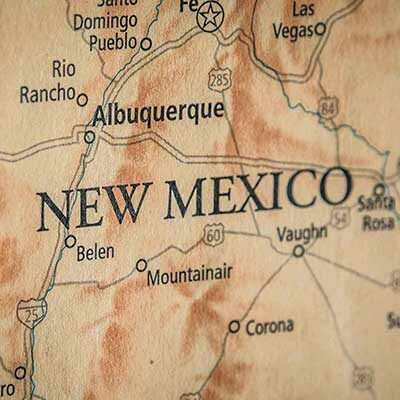What military history says about the future of PFAS cleanup
Laura Paskus
December 22, 2020
More than two years ago, New Mexico regulators learned that the Air Force had contaminated water beneath Holloman and Cannon Air Force bases with PFAS, or per- and polyfluoroalkyl substances. The two parties are locked in litigation as the state tries to compel the U.S. Department of Defense to clean up the toxic pollution, as well as map its spread.
Now, the Pentagon says it needs to study the possibility that PFAS polluted groundwater at five other places in the state: Fort Wingate, the Army National Guard armories in Rio Rancho and Roswell, the Army Aviation Support Facility in Santa Fe, and White Sands Missile Range.
In the final segment of our series of videos about New Mexico’s PFAS contamination from the military, we explore how issues of pollution, accountability, and transparency aren’t novel to the many New Mexico communities still facing the environmental and health fallout of uranium mining, nuclear weapons development and testing, and other types of pollution from military and weapons-related activities.
On December 18, the U.S. Environmental Protection Agency released interim guidelines for destroying and disposing of materials that contain PFAS. According to a statement from Dr. Olga Naidenko, vice president for science investigations at the Environmental Working Group, the EPA’s guidance does not demonstrate safe and effective disposal methods. Those guidelines are available online at the Federal Register.
Like many other problems, action on PFAS will need to be addressed by the incoming administration of President-elect Joe Biden, who pledged during the campaign that his administration will act on “designating PFAS as a hazardous substance, setting enforceable limits for PFAS in the Safe Drinking Water Act, prioritizing substitutes through procurement, and accelerating toxicity studies and research on PFAS.”
The Portsmouth Herald reports that another type of PFAS has been found in wells near the Coakley Landfill Superfund site in New Hampshire. From the story by Jeff McMenemy:
In a letter to homeowners near the Coakley Landfill, Christopher Buckman of CES, Inc., which works for the Coakley Landfill Group (CLG), mentioned PFOSA.
“In particular, perfluorooctanesulfonamide (PFOSA), a PFAS compound with no regulatory standards, was reported as detected at most locations during the spring 2020 sampling event at higher values than the fall 2019 results,” he said in the letter. “Our review indicates that not all of the detections for this and other PFAS compounds are related to the Coakley Landfill. The CLG will continue to monitor both the regulated and non-regulated PFAS compounds to better establish distribution, trends, and sources for the detections.”
In Wisconsin, efforts to tighten up regulations on firefighting foams that contain PFAS have been thwarted by state Republicans. For the Wisconsin Examiner, Erik Gunn reports that GOP lawmakers stripped parts of an emergency rule:
Republicans on the Joint Committee for the Review of Administrative Rules said the Department of Natural Resources (DNR) rule went outside the bounds of the legislation passed earlier this year that bans PFAS-containing firefighting foam except in limited circumstances. Democrats accused the majority of bowing to corporate pressure to “take the teeth out of a rule that the DNR has worked on so diligently,” in the words of Rep. Gary Hebl (D-Sun Prairie).
On the Farmington River, Connecticut public health officials have given the all-clear for anglers to eat fish from the river again. After a spill at Bradley International Airport sent PFAS-laden toxins into the river in June 2019, the state implemented an advisory against eating fish from portions of the river.
In The Guardian, Rob Bilott—the attorney upon whom the films “Dark Waters” and “The Devil We Know” are based—hits upon an uncomfortable truth. A small group of corporations and people have profited from the manufacture of PFAS, which is now found in the blood of humans across the planet.
Bilott writes of how in 1998, a West Virginia farmer whose cattle were dying approached him about the “white foaming crud defiling his creek where his cattle drank”:
Getting the answers required over two decades of litigation, continuing to this day. But like the cattle and other animals on his farm, Earl would not survive long enough to get all his answers. The dark secrets deliberately withheld from Earl about his creek and his dying cows, went far beyond his property line. The poison flowing into Earl’s creek was also leaching into the drinking water of 70,000 of his neighbors, but no one was being told a thing. And this was just the tip of the iceberg. In secret, the poison had in fact streamed all across the country, and into the bloodstreams of virtually every American.
Indeed, PFAS have been found far beyond the United States. A new study shows they’re also atop Mount Everest—shed from the waterproof gear used by adventurers.
That study, “Deposition of PFAS ‘forever chemicals’ on Mt. Everest,” was published in Science of the Total Environment. On its site, the American Institute of Physics has a summary: “This marks the first time that Everest snow and meltwater has been analyzed for PFAS, [lead author Kimberley] Miner says. The highest concentrations—which were found at Base Camp and Camp II—are two to three times higher than concentrations found in any other alpine environment.”
The samples, according to Miner, are from Nepal but illustrate that “PFAS are everywhere.”
If you’ve been affected by PFAS contamination in your community here in New Mexico, call our tip line at (505) 433-7242. To read more coverage of PFAS in New Mexico visit “Groundwater War: New Mexico’s Toxic Threat,” which includes a timeline of events and studies on PFAS.






